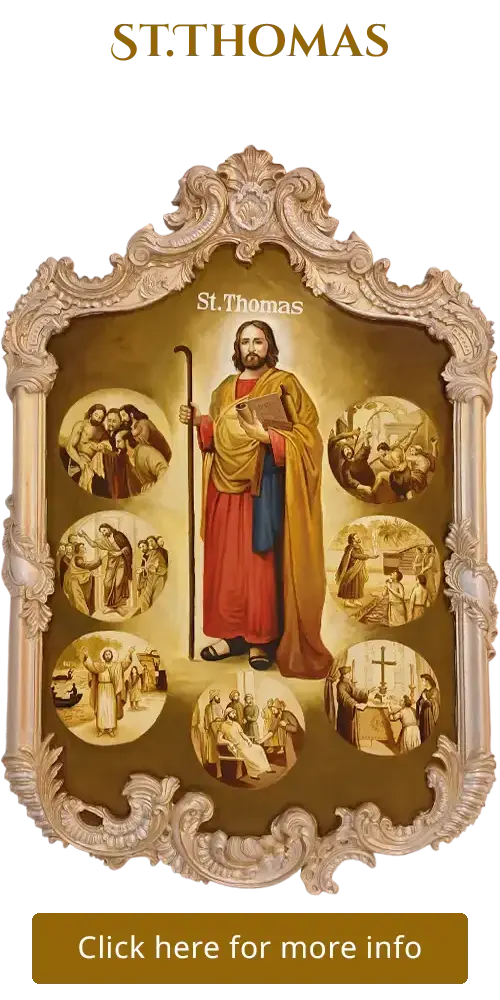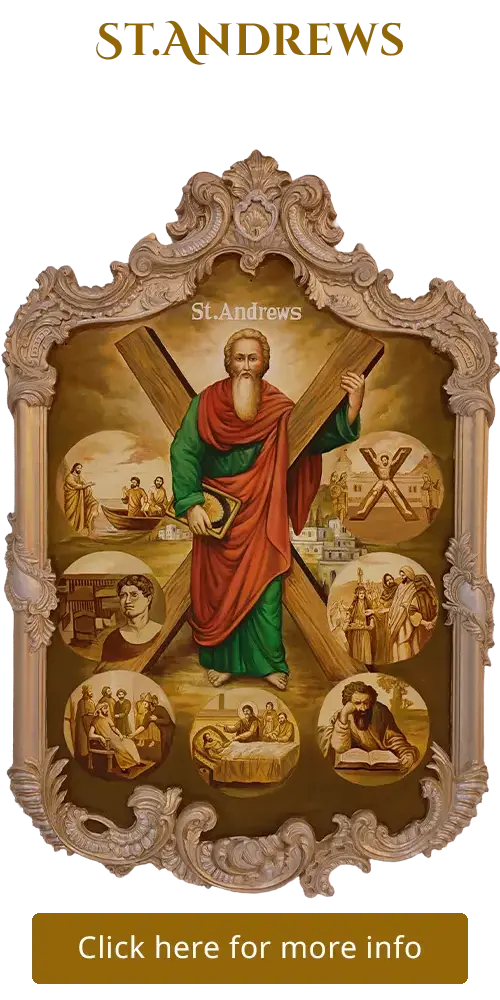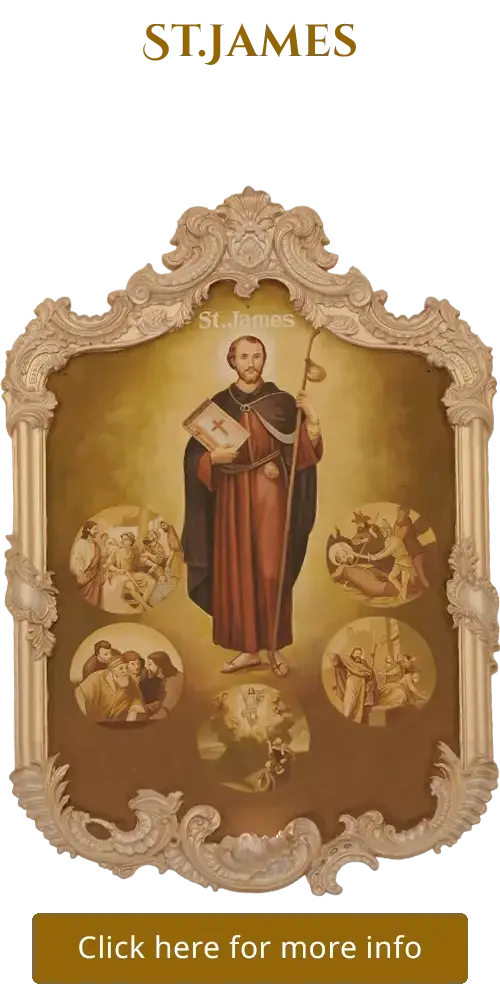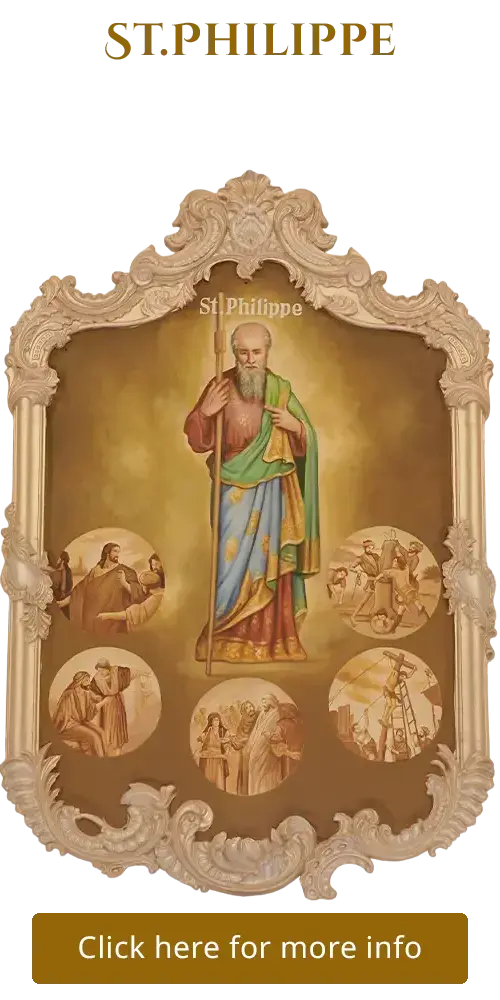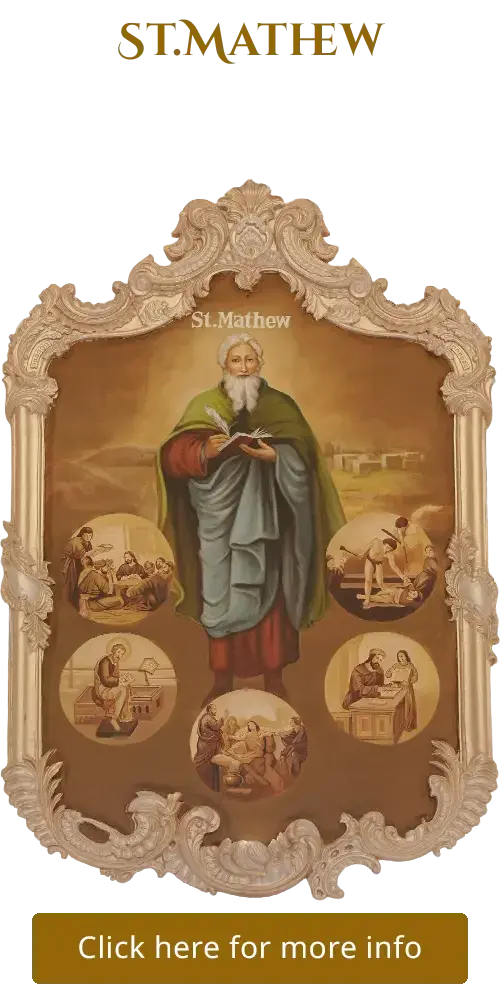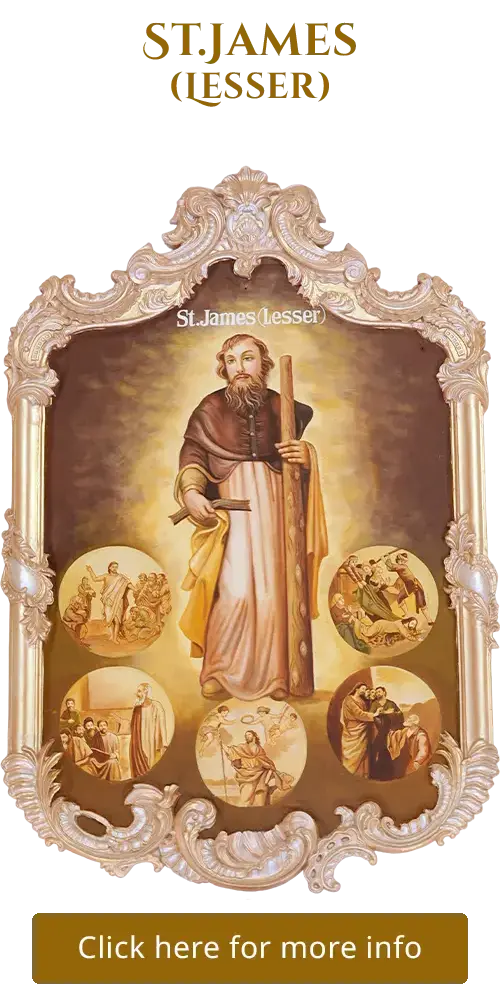St. Mary
Inside Paintings - North Wall
St. Mary
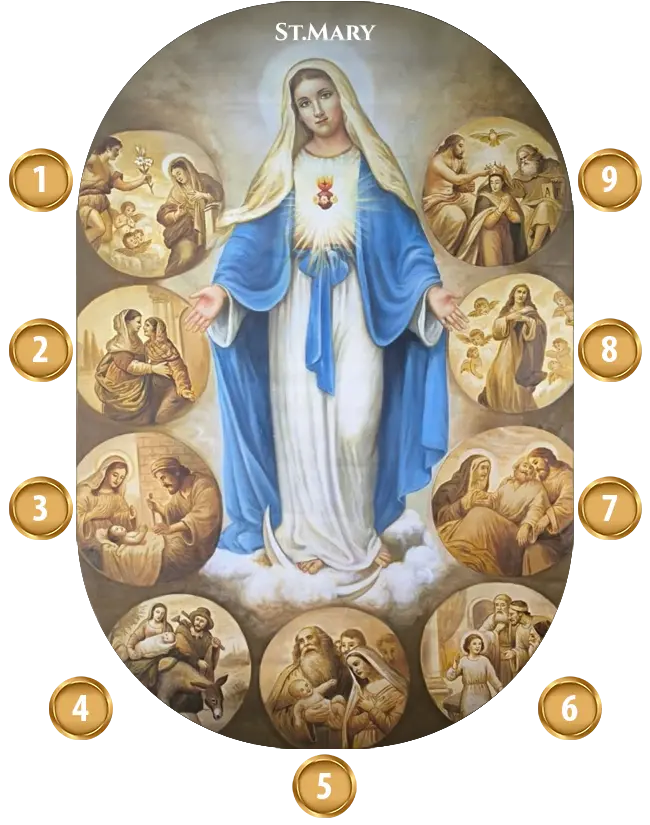
The life of the Blessed Virgin Mary is marked by humility, faith, and profound participation in God’s salvific plan. The Church, in her love and veneration for the Theotokos – the Mother of God – remembers key moments that reveal both God’s power and Mary’s faithfulness. These nine “miracles” are not simply events, but divine signs woven into salvation history.


1. The Annunciation – God’s Word Dwells in Her
Biblical reference: Luke 1:26–38
Description: In the sixth month of Elizabeth’s pregnancy, God sent the angel Gabriel to Nazareth, a town in Galilee, to a virgin named Mary, who is engaged to Joseph.
Gabriel greets Mary, telling her she is highly favored by God and that the Lord is with her.
Mary was greatly troubled at his words and wondered what kind of greeting this might be.
But the angel said to her, “Do not be afraid, Mary; you have found favor with God. You will conceive and give birth to a son, and you are to call him Jesus. He will be great and will be called the Son of the Most High. The Lord God will give him the throne of his father David, and he will reign over Jacob’s descendants forever; his kingdom will never end.”
“How will this be,” Mary asked the angel, “since I am a virgin?”
The angel answered, “The Holy Spirit will come on you, and the power of the Most High will overshadow you. So the holy one to be born will be called[a] the Son of God. Even Elizabeth your relative is going to have a child in her old age, and she who was said to be unable to conceive is in her sixth month. For no word from God will ever fail.”
“I am the Lord’s servant,” Mary answered. “May your word to me be fulfilled.” Then the angel left her.
The Feast of the Annunciation is celebrated on March 25th, nine months before Christmas.
2. The Visitation – The Unborn Bear Witness
Biblical reference: Luke 1:39–45
Description: Mary, having received the angel Gabriel’s message about her impending virgin birth of the Messiah, travels with haste to the hill country of Judea. She arrives at the home of Zechari′ah, whose wife Elizabeth is also miraculously pregnant with John the Baptist. As Mary greets Elizabeth, the baby (John the Baptist) leaps in her womb, and Elizabeth is filled with the Holy Spirit. Elizabeth exclaims, “Blessed are you among women, and blessed is the fruit of your womb!” recognizing Mary’s blessed state as the mother of the Messiah. Elizabeth also acknowledges Mary’s faith, saying, “Blessed is she who has believed that the Lord would fulfill his promises to her!”. And Mary remained with her about three months, and returned to her home.
3. The Nativity – God is Born in Poverty
Biblical reference: Luke 2:6–7
Description: Emperor Augustus has demanded that every man across the Empire return with his family to his place of birth for the census. As a direct descendant of King David, Joseph is forced to travel 110 kilometers (68 mi) across Judea’s rocky terrain from Nazareth to Bethlehem, his native homeland. With Mary on a donkey laden with supplies, it takes the couple nearly four weeks to reach Bethlehem. Upon arriving in town, Mary goes into labor, and Joseph frantically seeks a place for her to deliver. There is, however, no room in any inn or home because of the people arriving for the census, but at the last minute, an innkeeper offers his stable for shelter.
In the humblest of places, the Eternal Word is born of Mary. She swaddles the Infinite in cloth and lays Him in a manger. The angels glorify, and shepherds adore. The one who gave birth without corruption is revealed to the world.
4. The Flight into Egypt – God Protected by His Mother
Biblical reference: Matthew 2:13–15
Description: The Magi visit Herod and reveal to him that the Messiah is still a child and he will be a Messiah “for the lowest of men to the highest of kings.” Shocked by this, Herod asks that they visit the newborn Messiah and report the child’s location back to him, under the pretense that he, too, would like to worship him, while in fact, he plans to kill the baby for fear of a new king usurping him. The Magi arrive at the stable where Mary has given birth to Jesus, and they present the infant with gifts of gold, frankincense, and myrrh.
Suspicious of his intentions, the Magi avoid Herod, returning home via a different route. Herod realizes that the Magi have tricked him and orders the death of every boy in Bethlehem under the age of two. In the present, Joseph is warned in a dream of the danger and flees to Egypt with Mary and Jesus, Mary knowing her son will bring hope to mankind.
They stayed there until Herod’s death, which was also revealed to Joseph by an angel in a dream.
5. The Presentation in the Temple – The Sword Foretold
Biblical reference: Luke 2:22–40
Description: According to Mosaic Law, women were to be purified 40 days after giving birth to a son, and the firstborn son was to be presented to God in the Temple.
As Mary and Joseph presented Jesus, they encountered the elderly Simeon and Anna in the Temple. Simeon, guided by the Holy Spirit, recognized Jesus as the Messiah and uttered a prophecy, known as the Nunc Dimittis, expressing his readiness to depart from this world.
Simeon told Mary that a sword would pierce her soul. This prophecy highlights Mary’s future suffering as she witnesses her son’s passion and crucifixion. It signifies her deep sorrow and emotional pain during Jesus’s public ministry and especially at the foot of the cross.
The Presentation is not just a ritualistic event but a pivotal moment where the Old and New Covenants converge, and Mary’s role as Co-Redemptrix is foreshadowed, according to early teachings.
The Feast of the Presentation is celebrated on February 2nd.
6. The Finding in the Temple – The Child Teaches the Wise
Biblical reference: Luke 2:41–52
Description: The event takes place during the Passover feast in Jerusalem, which Jesus and his family attended annually. After the feast, Mary and Joseph unknowingly leave Jesus behind in Jerusalem, assuming he is with other relatives and friends. After a day’s travel, they realize Jesus is missing and return to Jerusalem to search for him.
They find Jesus in the temple, sitting among the teachers, listening to them and asking them questions. The teachers are amazed by his understanding and answers. Mary and Joseph are astonished to find Jesus there, and Mary expresses her worry, asking why he treated them this way. Jesus responds by asking why they were searching for him, stating that he must be about his Father’s business. This is often interpreted as a reference to his divine mission. While Mary and Joseph do not fully understand his words, they do not doubt that he is the Son of God.
7. The Passing of Joseph – Guardian of the Holy Family
Historical reference: Traditional sources such as Mystical City of God by Venerable Mary of Agreda
Description: Christian tradition holds that St. Joseph died before Jesus began his public ministry, passing peacefully in the presence of Jesus and Mary.
This belief highlights his blessed death, surrounded by family and graced by their comfort, making him the patron saint of a happy death, often invoked by the dying.
Worn from years of labor, Joseph’s final eight years were marked by illness, which God allowed to deepen his sanctity through patience. Mary lovingly cared for him, taking up spinning and weaving to support them, sometimes with Jesus’ miraculous help. Despite fevers and rheumatism, Joseph endured with humility, earning Mary’s admiration. She nursed him devotedly, preparing meals and easing his pain. In his final days, Jesus and Mary stayed by his side, with angels offering music and visions. As death neared, Jesus blessed Joseph, promising him honor among angels and saints, and tasked him with bringing joyful news to those in limbo. In Jesus’ arms, with Mary at his feet and angels illuminating the room, Joseph died peacefully. Mary prepared his body for burial, and a simple procession with Jesus and angels laid him in a donated tomb.
8. The Dormition – A Holy Departure
Historical reference: Sacred Tradition
Description: On August 15th, millions of Orthodox faithful gather to celebrate the Dormition of the Mother of God, marking Mary’s “falling asleep” and her bodily assumption into heaven.
The story goes that after Jesus ascended, Mary stayed in Jerusalem under the care of the apostles, and when her time came, they all miraculously gathered around her bedside. Mary surrendered her soul to Christ, who received her as a radiant infant—symbolizing her eternal rebirth in God’s presence. According to tradition, her tomb was found empty three days later, just like her son’s resurrection. This feast emphasizes not just her death but her assumption, showing God’s ultimate plan for humanity -resurrection in both body and soul.
Theologically, it reminds believers that Mary, as the Theotokos or God-bearer, is the first to fully experience what awaits all the faithful.
9. Her Assumption – Taken into Heavenly Glory
Historical reference: Tradition
Description: The Assumption of Mary is a beautiful belief that marks the end of her earthly life, where, instead of facing the decay of death, she was taken up body and soul into the glory of heaven.
This moment is vividly captured in the Book of Revelation, which describes a magnificent vision: “A great sign appeared in heaven: a woman clothed with the sun, and the moon beneath her feet, and on her head a crown of twelve stars” (Revelation 12:1). For Christians, this image points to Mary, radiant and exalted, standing as a beacon of divine promise.
Her Assumption isn’t just about her unique role; it’s a powerful sign of hope for all believers, showing that God’s promise of eternal life extends to everyone who follows Him. Mary’s life, lived in complete faith and devotion, culminated in this extraordinary moment where she was lifted into heaven’s embrace.
The image often associated with this event shows her being crowned by the Holy Trinity—God the Father, Jesus her Son, and the Holy Spirit, depicted as a dove. This crowning signifies her queenship, not as a ruler in an earthly sense, but as the honored mother of Christ, reigning in heaven’s glory.
For those who reflect on it, the Assumption offers deep comfort, reminding us that death is not the end but a doorway to eternal life. It’s a call to trust in God’s plan, just as Mary did, knowing that He prepares a place for us beyond this world. Her story encourages us to live with hope, aiming for the same heavenly home where she now resides in splendor.


